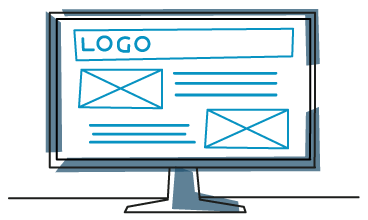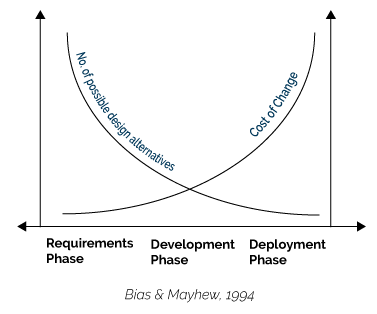The general rule of thumb in organisations that focus on improving user experience is that every $1 invested delivers a return of $10-$100. The problem with that is the range is so huge it seems unbelievable.
Below we have provided a variety of information to help anyone trying to put together a business case for UX research. The contents represent compelling content and assets we have come across over the years and that our customers find useful. If you have something useful that you use, please send us a link and we will share it.

88% of online consumers claim that they are less likely to return to a site after a negative user experience
In the context of website and app design and development, UX research provides value during the development phase and for optimising a live website or app.
COST OF CHANGE
There are several arguments for carrying out usability testing but one of the most visual is the chart on the right created by Bias and Mayhew in 1994 for their book “Cost justifying usability” Developed in 1994 it is as true now as it was then. It shows that during the development of a digital product, from the requirements phase to the deployment phase, the cost of change increases as the number of design alternatives reduces.
By utilising UX research to refine and enhance ideas throughout the design process we end up with a better, more effective digital product and have no need for expensive and limited rework at the end.

The chart is powerful because it is intuitively correct and allows us to consider the value of usability testing at every stage of development and into operation. Clearly if usability issues that impact the operation of a digital product are found after launch, the choices available to rectify those issues and cost to implement change is significant. A digital product owner confronted with this situation has limited choices:
- Spend and rectify
- Wait for the next redesign
- Fix what you can cost effectively attend to and accept lower conversion / high abandonment
We see this regularly when working with digital product owners when usability testing a live website for the first time, whereby issues fall into two buckets: those that can be rectified now; and those that must wait for the redesign because they are too expensive or technically difficult to solve.
REVENUE
Of course, the most common metric of ROI is financial, and a tested-to-breaking-point product, with a user-centric UI, will ensure the customer’s experience is a pleasant one, encouraging more conversions, and, in turn, increased sales and revenue
Usability testing is proven to improve conversion on eCommerce website.
Calculating ROI
If you are trying to actually calculate ROI of UX research here are some really useful resources:
ROI calculators from Human Factors:
Human Factors provide six different calculators based on the following criteria:
- Increased productivity
- Reduced reliance on help desks
- Increased conversion rate
- Reduced costs on formal training
- Decreased drop off rate
- Reduced learning curve
Resources
The UX Fund
Forrester
This report looks at company growth rate between 2010 and 2014 encompasses a range of industries and indicates where a focus on customer experience can deliver the best growth rate.
Watermark Consulting
This white paper looks at the stock market performance of leaders and laggards in the Forrester annual experience index ratings. It shows that over an 8 year period the S&P index grew 72.3%, customer experience leaders stock grew 107.5% and customer experience laggards stock grew by only 27.6%.
“By the year 2020 customer experience will surpass both price and product as the most important brand differentiator “
USER EXPERIENCE
If the user’s experience of the digital product is damaged or frustrated by poor usability, there is a risk that a new user will look elsewhere. Possibly to a direct competitor who is delivering a superior user experience. The impact includes the following:
- Wasted PPC marketing costs for driving traffic that results in poor conversion
- Higher PPC costs due to poor conversion scores
- Lost opportunity to capture prospect details for future marketing
LOSS OF LOYAL CUSTOMERS
It isn’t just prospects who’ll be deterred from using and ultimately converting on your website. The patience, along with the trust, of existing and loyal customers will soon wither when they find themselves unable to achieve their goals with relative ease. This is also the case when direct competitors improve their websites. The impact can be:
- Lower average basket size / Average revenue per user
- Higher marketing costs to stand still
WORD OF MOUTH
Social media and review sites such as Trustpilot are now key sources of information for users when seeking recommendations for brands, products and services. Poor user experience, particularly where people report greater complexity than is required or expected can be very damaging.
According to OJM Digital, People enjoy sharing experiences with 78% sharing because of a good experience (47% because of a bad one).
They can make or break the online presence of organisations large and small. Once word gets out that your website or app is a usability vacuum, those who might’ve been interested in your offering soon won’t be. Conversely, and particularly on mobile the news of a positive experience can also travel fast.
In usability testing, particularly on eCommerce websites, customer reviews are a crucial element of the purchase cycle. Most users refer to them before making a purchase decision
DEVELOPMENT
Development time may well be compromised without the safeguards of a rigid UX framework. Discovering faults late in the product development can extend the development cycle and increase the development costs.
PRODUCTIVITY
Savings can also be made through an increase in productivity of any staff that have to interact with a product for the purposes of customer fulfilment etc. Back end systems require rigorous testing to ensure the design and UI are conducive to an experience that cuts the time it takes to complete a task, allowing the employee to achieve more. This is particularly true when implementing functions such as Chat and Chatbots.



